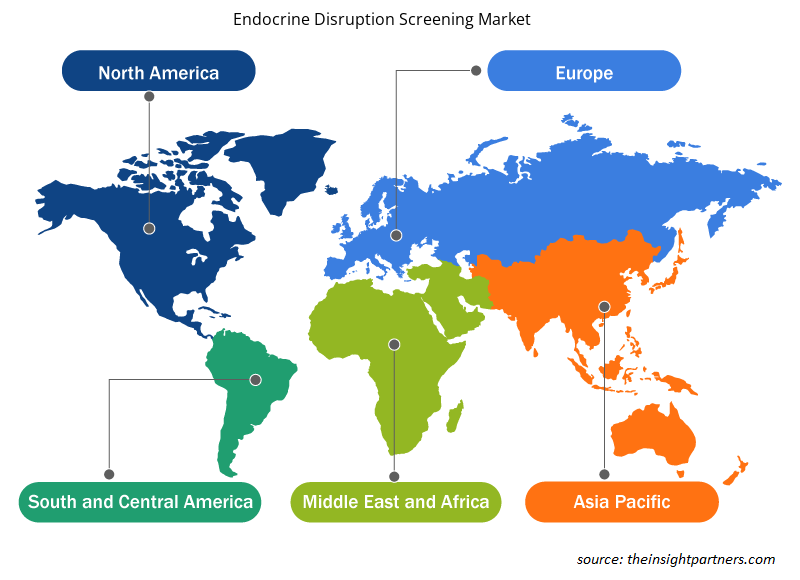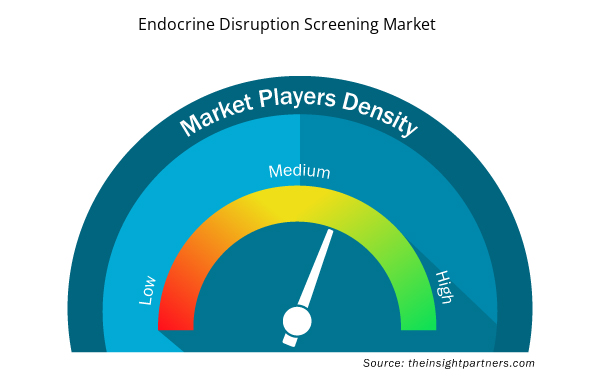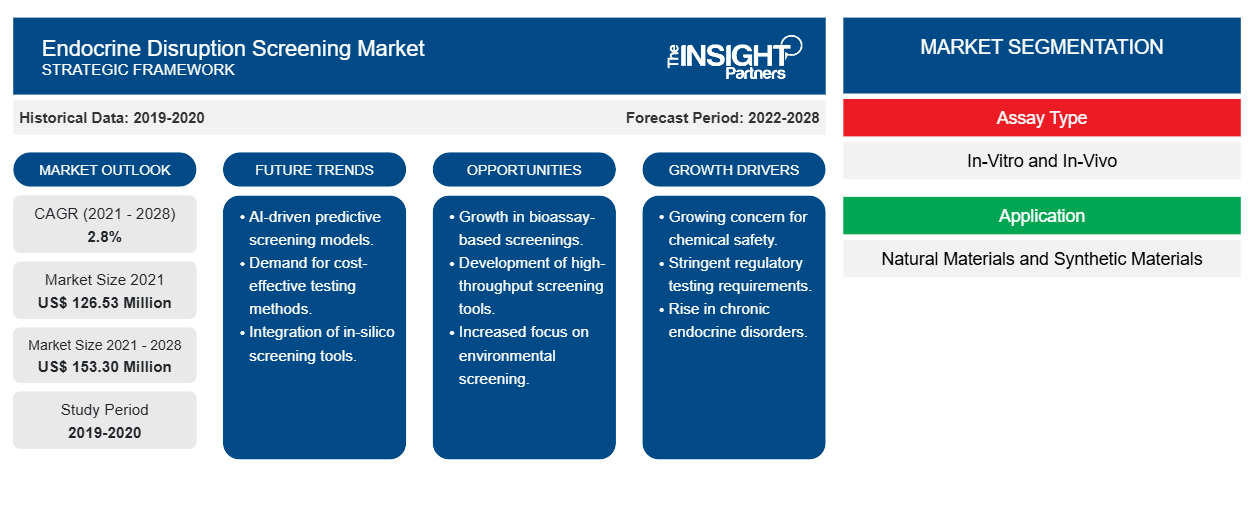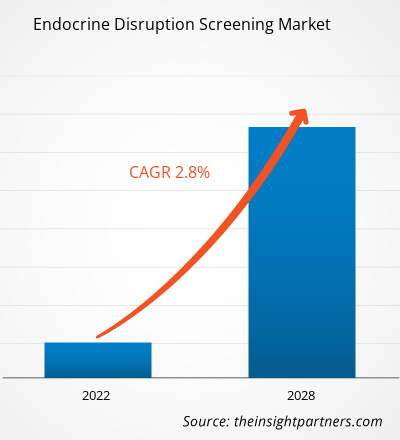من المتوقع أن يصل سوق فحص اضطرابات الغدد الصماء إلى 153.30 مليون دولار أمريكي بحلول عام 2028 من 126.53 مليون دولار أمريكي في عام 2021؛ ومن المتوقع أن ينمو بمعدل نمو سنوي مركب قدره 2.8٪ خلال الفترة من 2021 إلى 2028.
تتمتع العديد من المواد الكيميائية، سواء الطبيعية أو من صنع الإنسان، بالقدرة على تقليد أو التدخل في عمل الجهاز الغددي الذي ينظم هرمونات الجسم. وقد ارتبطت هذه المواد الكيميائية، المعروفة باسم المواد المسببة لاضطرابات الغدد الصماء، باضطرابات النمو والتكاثر والدماغ والجهاز المناعي وغيرها من الاضطرابات. ويمكن أن توجد المواد المسببة لاضطرابات الغدد الصماء في مجموعة متنوعة من العناصر العادية، مثل بعض الزجاجات والحاويات البلاستيكية، وبطانات علب الطعام المعدنية، والمنظفات، ومثبطات اللهب، والأغذية، والألعاب، ومستحضرات التجميل، والمبيدات الحشرية. ويتم فحص المبيدات الحشرية والمواد الكيميائية والسموم البيئية باستخدام طريقة من مستويين لمعرفة تأثيرها المحتمل على أنظمة هرمون الاستروجين والأندروجين وهرمون الغدة الدرقية من خلال فحص المواد المسببة لاضطرابات الغدد الصماء.
يعود نمو سوق فحص اضطرابات الغدد الصماء إلى الأبحاث المتزايدة في قطاع التكنولوجيا الحيوية والانتشار المتزايد لاضطرابات الغدد الصماء. ومع ذلك، فإن التكلفة العالية لتكنولوجيا الفحص تعيق نمو السوق.
قم بتخصيص هذا التقرير ليناسب متطلباتك
ستحصل على تخصيص لأي تقرير - مجانًا - بما في ذلك أجزاء من هذا التقرير، أو تحليل على مستوى الدولة، وحزمة بيانات Excel، بالإضافة إلى الاستفادة من العروض والخصومات الرائعة للشركات الناشئة والجامعات
- احصل على أهم اتجاهات السوق الرئيسية لهذا التقرير.ستتضمن هذه العينة المجانية تحليلاً للبيانات، بدءًا من اتجاهات السوق وحتى التقديرات والتوقعات.
رؤى السوق
الانتشار المتزايد لاضطرابات الغدد الصماء يحرك سوق فحص اضطرابات الغدد الصماء
ضخامة الأطراف (الإفراط في إنتاج هرمون النمو)، والسمنة، ومتلازمة التمثيل الغذائي، واختلال سكر الدم أثناء الصيام، واختلال تحمل الجلوكوز، وهشاشة العظام، وهشاشة العظام، ونقص فيتامين د الخفيف إلى المتوسط، وضعف الانتصاب، وخلل شحميات الدم، والتهاب الغدة الدرقية من بين الاضطرابات الغدد الصماء التي يبلغ معدل انتشارها الجماعي 5% على الأقل بين البالغين في الولايات المتحدة. ومن بين هذه الحالات، يعاني الذكور من أعلى معدل للإصابة بضعف الانتصاب، في حين تعاني الإناث من أعلى معدل للإصابة بهشاشة العظام. ويعد مرض السكري عند الأطفال وورم الغدة النخامية من أقل الحالات شيوعًا، حيث يصيب أقل من 1% من سكان الولايات المتحدة. أما سرطان قشر الكظر، وورم القواتم، وأورام الغدة النخامية فهي الحالات الأقل شيوعًا. كما أن فرط نشاط الغدة جار الدرقية واضطرابات الغدة الدرقية أكثر شيوعًا بين النساء. وينتشر مرض السكري بين الأقليات العرقية. تعد الأمراض الغدد الصماء والتمثيل الغذائي من بين أكثر الأمراض البشرية شيوعًا في العصر الحديث، وخاصة في الولايات المتحدة وغيرها من البلدان التي تنفذ برامج التغذية والفحص الشاملة للأفراد المعرضين للخطر. يمكن أن تؤدي الاضطرابات الغدد الصماء مثل فرط نشاط الغدة جار الدرقية، وقصور الغدد التناسلية الأولي والثانوي، ونقص هرمون النمو، وقصور الغدة الدرقية إلى اضطرابات أخرى، مثل مرض العظام الأيضي ومرض السكري. وبالتالي، فإن الانتشار المتزايد لمثل هذه الحالات وزيادة حدوثها يدفعان الطلب على منتجات فحص اضطرابات الغدد الصماء.
رؤى تعتمد على نوع الاختبار
ينقسم سوق فحص اضطرابات الغدد الصماء، حسب نوع الاختبار، إلى اختبار داخل المختبر واختبار داخل الجسم الحي. قاد قطاع الاختبار داخل المختبر السوق في عام 2021، حيث ساهم بحصة سوقية بلغت 64.45%، ومن المتوقع أن يحتفظ بهيمنته خلال فترة التوقعات ليشكل حصة سوقية تبلغ 65.73% من إجمالي الإيرادات المتولدة في عام 2028.
رؤى قائمة على التطبيق
من حيث التطبيق، ينقسم سوق فحص الاضطرابات الغدد الصماء إلى مواد طبيعية ومواد صناعية. في عام 2021، استحوذ قطاع المواد الطبيعية على حصة أكبر من السوق. علاوة على ذلك، من المتوقع أن ينمو سوق نفس القطاع بمعدل نمو سنوي مركب أسرع بنسبة 3.1% خلال الفترة 2021-2028.
مصدر الرؤى القائمة على النفايات
تم تقسيم سوق فحص الاضطرابات الغدد الصماء، حسب مصدر النفايات، إلى حرق النفايات ومكبات النفايات، والجريان الزراعي، والنفايات الصناعية والبلدية، ومياه مصانع اللب، والمنتجات الاستهلاكية، وغيرها. في عام 2021، احتل قطاع حرق النفايات ومكبات النفايات الحصة الأكبر من السوق. علاوة على ذلك، من المتوقع أن ينمو سوق نفس القطاع بأسرع معدل نمو سنوي مركب بنسبة 3.5٪ خلال الفترة 2021-2028.
رؤى مبنية على الطريقة
تم تقسيم سوق فحص الاضطرابات الغدد الصماء، حسب الطريقة، إلى تنشيط مستقبلات الإستروجين (ER)، وتنشيط مستقبلات الأندروجين (AR)، وتعديل مستقبلات الأندروجين (AR)، وربط مستقبلات الإستروجين ألفا (ER)، وربط مستقبلات الإستروجين بيتا (ER)، وربط مستقبلات الأندروجين (AR)، وتكوين الستيرويد، واختبار الأروماتاز، وغيرها. في عام 2021، احتل قطاع تنشيط مستقبلات الإستروجين (ER) الحصة الأكبر من السوق. علاوة على ذلك، من المتوقع أن ينمو سوق نفس القطاع بأسرع معدل نمو سنوي مركب بنسبة 3.7٪ من عام 2021 إلى عام 2028.
رؤى تعتمد على المستخدم النهائي
يتم تقسيم سوق فحص الاضطرابات الغدد الصماء، بناءً على الاستخدام النهائي، إلى شركات الأدوية والمستحضرات الصيدلانية الحيوية، وشركات مستحضرات التجميل والمنتجات المنزلية، وصناعة الأغذية، والصناعة الكيميائية. في عام 2021، استحوذ قطاع شركات الأدوية والمستحضرات الصيدلانية الحيوية على أكبر حصة من السوق. علاوة على ذلك، من المتوقع أن ينمو سوق نفس القطاع بأسرع معدل نمو سنوي مركب بنسبة 3.3٪ خلال الفترة 2021-2028.
إن إطلاق المنتجات والموافقة عليها هي عادة استراتيجيات تتبناها الشركات لتوسيع نطاق وجودها العالمي ومحافظ منتجاتها. وعلاوة على ذلك، يركز اللاعبون في سوق فحص الاضطرابات الغدد الصماء على استراتيجية الشراكة لتوسيع قاعدة عملائهم، الأمر الذي يسمح لهم بدوره بالحفاظ على اسم علامتهم التجارية في جميع أنحاء العالم.
رؤى إقليمية حول سوق فحص اضطرابات الغدد الصماء
لقد قام المحللون في Insight Partners بشرح الاتجاهات والعوامل الإقليمية المؤثرة على سوق فحص اضطرابات الغدد الصماء طوال فترة التوقعات بشكل شامل. يناقش هذا القسم أيضًا قطاعات سوق فحص اضطرابات الغدد الصماء والجغرافيا في جميع أنحاء أمريكا الشمالية وأوروبا ومنطقة آسيا والمحيط الهادئ والشرق الأوسط وأفريقيا وأمريكا الجنوبية والوسطى.

- احصل على البيانات الإقليمية المحددة لسوق فحص اضطرابات الغدد الصماء
نطاق تقرير سوق فحص اضطرابات الغدد الصماء
| سمة التقرير | تفاصيل |
|---|---|
| حجم السوق في عام 2021 | 126.53 مليون دولار أمريكي |
| حجم السوق بحلول عام 2028 | 153.30 مليون دولار أمريكي |
| معدل النمو السنوي المركب العالمي (2021 - 2028) | 2.8% |
| البيانات التاريخية | 2019-2020 |
| فترة التنبؤ | 2022-2028 |
| القطاعات المغطاة | حسب نوع التحليل
|
| المناطق والدول المغطاة | أمريكا الشمالية
|
| قادة السوق وملفات تعريف الشركات الرئيسية |
|
كثافة اللاعبين في السوق: فهم تأثيرها على ديناميكيات الأعمال
يشهد سوق فحص اضطرابات الغدد الصماء نموًا سريعًا، مدفوعًا بالطلب المتزايد من المستخدم النهائي بسبب عوامل مثل تفضيلات المستهلك المتطورة والتقدم التكنولوجي والوعي الأكبر بفوائد المنتج. ومع ارتفاع الطلب، تعمل الشركات على توسيع عروضها والابتكار لتلبية احتياجات المستهلكين والاستفادة من الاتجاهات الناشئة، مما يؤدي إلى زيادة نمو السوق.
تشير كثافة اللاعبين في السوق إلى توزيع الشركات أو المؤسسات العاملة في سوق أو صناعة معينة. وهي تشير إلى عدد المنافسين (اللاعبين في السوق) الموجودين في مساحة سوق معينة نسبة إلى حجمها أو قيمتها السوقية الإجمالية.
الشركات الرئيسية العاملة في سوق فحص اضطرابات الغدد الصماء هي:
- مجموعة بيولوجية إبداعية
- زينومتريكس ايه جي
- نهر تشارلز
- يوروفينز العلمية
- سميثرز
إخلاء المسؤولية : الشركات المذكورة أعلاه ليست مرتبة بأي ترتيب معين.

- احصل على نظرة عامة على أهم اللاعبين الرئيسيين في سوق فحص اضطرابات الغدد الصماء
يقسم التقرير سوق فحص اضطرابات الغدد الصماء على النحو التالي
سوق فحص اضطرابات الغدد الصماء – حسب نوع الاختبار
- في المختبر
- في الجسم الحي
سوق فحص اضطرابات الغدد الصماء – حسب التطبيق
- المواد الطبيعية
- المواد الاصطناعية
سوق فحص اضطرابات الغدد الصماء – حسب مصادر النفايات
- حرق النفايات ومكب النفايات
- الجريان الزراعي
- النفايات الصناعية والبلدية
- مخلفات مصانع اللب
- المنتجات الاستهلاكية
- آحرون
سوق فحص اضطرابات الغدد الصماء – حسب الطريقة
- معاملات مستقبلات هرمون الاستروجين (ER).
- تنشيط مستقبلات الأندروجين (AR)
- تعديل مستقبلات الأندروجين
- ربط مستقبلات هرمون الاستروجين ألفا (ER-alpha).
- ربط مستقبلات هرمون الاستروجين بيتا (ER-beta).
- ربط مستقبلات الأندروجين (AR)
- تكوين الستيرويد
- تحليل الأروماتيز
- آحرون
سوق فحص اضطرابات الغدد الصماء – حسب المستخدم النهائي
- شركات الأدوية والمستحضرات الصيدلانية الحيوية
- الصناعة الكيميائية
- صناعة الأغذية
- شركات مستحضرات التجميل والمنتجات المنزلية
سوق فحص اضطرابات الغدد الصماء – حسب المنطقة الجغرافية
- أمريكا الشمالية
- نحن
- كندا
- المكسيك
- أوروبا
- المملكة المتحدة
- ألمانيا
- فرنسا
- إيطاليا
- إسبانيا
- بقية أوروبا
- آسيا والمحيط الهادئ
- الصين
- اليابان
- الهند
- أستراليا
- كوريا الجنوبية
- بقية آسيا والمحيط الهادئ
- الشرق الأوسط وأفريقيا
- الامارات العربية المتحدة
- المملكة العربية السعودية
- جنوب أفريقيا
- بقية الشرق الأوسط وأفريقيا
- أمريكا الجنوبية والوسطى
- البرازيل
- الأرجنتين
- بقية أمريكا الجنوبية والوسطى
نبذة عن الشركة
- مجموعة بيولوجية إبداعية
- زينومتريكس ايه جي
- مختبرات تشارلز ريفر، المحدودة
- يوروفينز العلمية المحدودة
- سميثرز
- شركة اس جي اس اس ايه
- مؤسسة جيه آر إف العالمية
- علوم التغذية ميريو
- ألفا للتحليلات المحدودة
- التحليل التاريخي (سنتان)، السنة الأساسية، التوقعات (7 سنوات) مع معدل النمو السنوي المركب
- تحليل PEST و SWOT
- حجم السوق والقيمة / الحجم - عالميًا وإقليميًا وقطريًا
- الصناعة والمنافسة
- مجموعة بيانات Excel



Report Coverage
Revenue forecast, Company Analysis, Industry landscape, Growth factors, and Trends

Segment Covered
This text is related
to segments covered.

Regional Scope
North America, Europe, Asia Pacific, Middle East & Africa, South & Central America

Country Scope
This text is related
to country scope.
الأسئلة الشائعة
The global endocrine disruption screening market is expected to reach US$ 153.30 million by 2028 from US$ 126.53 million in 2021. The market is estimated to grow with a CAGR of 2.8% from 2021-2028.
Regulatory agencies throughout the world are grappling with the task of assessing the hazards and dangers to human and ecosystem health that may come from exposure to substances that disrupt the normal functioning of endocrine systems. The rapidly rising number of compounds in commerce, along with the dependence on conventional, expensive animal tests for hazard assessment – frequently with insufficient sensitivity to many critical processes of endocrine disruption – poses persistent problems for chemical management. As a result, there are only a few compounds for which there is enough evidence to determine whether there is endocrine toxicity, and hence only a few substances with full hazard categorization. To address this issue, regulatory assessment of endocrine disrupting chemicals (EDCs) is benefiting from a toxicology revolution focused on New Approach Methodologies (NAMs) to more rapidly identify, prioritize, and assess the potential risks from chemical exposure using novel, more efficient, and mechanistically driven methodologies, and tools.
The Asia Pacific region is expected to be the fastest-growing region among all other regions. The market is this region is expected to grow significantly in countries such as China, Japan, South Korea, and India. The growth of the market in this region is expected to grow at a faster pace owing to factors such as high prevalence of this hormonal changes, and the rise in healthcare awareness. Additionally, developing healthcare infrastructure and increasing investments are projected to drive the Asia Pacific endocrine disruption screening market during the forecast period.
The growth of the endocrine disruption screening market is mainly attributed to factors such as the increasing prevalence of endocrine disorders coupled with rising incidence of diabetes. However, the high cost of screening technology and devices is hindering the market growth. In July 2021, DDA platform, the division of Creative Bioarray, launched a wide range of genotoxicity testing services (non-GLP) into the service segment of in vitro toxicity services which is contributing to the growth of the target market. Such strategic steps are also projected to drive the market growth.
Many chemicals, both natural and man-made, can imitate or interfere with the endocrine system, which regulates the body's hormones. These chemicals, known as endocrine disruptors, have been related to developmental, reproductive, cognitive, immunological, and other issues. Many ordinary products include endocrine disruptors, such as some plastic bottles and containers, metal food can liners, detergents, flame retardants, food, toys, cosmetics, and pesticides. Some hormone-disrupting compounds take a long time to degrade in the environment. As a result of this trait, they can become dangerous over time. Pesticides, chemicals, and environmental toxins are screened using a two-tiered method for their potential effect on the estrogen, androgen, and thyroid hormone systems by the endocrine disruptor screening.
Trends and growth analysis reports related to Life Sciences : READ MORE..
The List of Companies - Endocrine Disruption Screening Market
- CREATIVE BIOARRAY
- XENOMETRIX AG
- CHARLES RIVER
- EUROFINS SCIENTIFIC
- SMITHERS
- SGS SA
- JRF GLOBAL
- MéRIEUX NUTRISCIENCES
- ALPHA ANALYTICAL
The Insight Partners performs research in 4 major stages: Data Collection & Secondary Research, Primary Research, Data Analysis and Data Triangulation & Final Review.
- Data Collection and Secondary Research:
As a market research and consulting firm operating from a decade, we have published and advised several client across the globe. First step for any study will start with an assessment of currently available data and insights from existing reports. Further, historical and current market information is collected from Investor Presentations, Annual Reports, SEC Filings, etc., and other information related to company’s performance and market positioning are gathered from Paid Databases (Factiva, Hoovers, and Reuters) and various other publications available in public domain.
Several associations trade associates, technical forums, institutes, societies and organization are accessed to gain technical as well as market related insights through their publications such as research papers, blogs and press releases related to the studies are referred to get cues about the market. Further, white papers, journals, magazines, and other news articles published in last 3 years are scrutinized and analyzed to understand the current market trends.
- Primary Research:
The primarily interview analysis comprise of data obtained from industry participants interview and answers to survey questions gathered by in-house primary team.
For primary research, interviews are conducted with industry experts/CEOs/Marketing Managers/VPs/Subject Matter Experts from both demand and supply side to get a 360-degree view of the market. The primary team conducts several interviews based on the complexity of the markets to understand the various market trends and dynamics which makes research more credible and precise.
A typical research interview fulfils the following functions:
- Provides first-hand information on the market size, market trends, growth trends, competitive landscape, and outlook
- Validates and strengthens in-house secondary research findings
- Develops the analysis team’s expertise and market understanding
Primary research involves email interactions and telephone interviews for each market, category, segment, and sub-segment across geographies. The participants who typically take part in such a process include, but are not limited to:
- Industry participants: VPs, business development managers, market intelligence managers and national sales managers
- Outside experts: Valuation experts, research analysts and key opinion leaders specializing in the electronics and semiconductor industry.
Below is the breakup of our primary respondents by company, designation, and region:

Once we receive the confirmation from primary research sources or primary respondents, we finalize the base year market estimation and forecast the data as per the macroeconomic and microeconomic factors assessed during data collection.
- Data Analysis:
Once data is validated through both secondary as well as primary respondents, we finalize the market estimations by hypothesis formulation and factor analysis at regional and country level.
- Macro-Economic Factor Analysis:
We analyse macroeconomic indicators such the gross domestic product (GDP), increase in the demand for goods and services across industries, technological advancement, regional economic growth, governmental policies, the influence of COVID-19, PEST analysis, and other aspects. This analysis aids in setting benchmarks for various nations/regions and approximating market splits. Additionally, the general trend of the aforementioned components aid in determining the market's development possibilities.
- Country Level Data:
Various factors that are especially aligned to the country are taken into account to determine the market size for a certain area and country, including the presence of vendors, such as headquarters and offices, the country's GDP, demand patterns, and industry growth. To comprehend the market dynamics for the nation, a number of growth variables, inhibitors, application areas, and current market trends are researched. The aforementioned elements aid in determining the country's overall market's growth potential.
- Company Profile:
The “Table of Contents” is formulated by listing and analyzing more than 25 - 30 companies operating in the market ecosystem across geographies. However, we profile only 10 companies as a standard practice in our syndicate reports. These 10 companies comprise leading, emerging, and regional players. Nonetheless, our analysis is not restricted to the 10 listed companies, we also analyze other companies present in the market to develop a holistic view and understand the prevailing trends. The “Company Profiles” section in the report covers key facts, business description, products & services, financial information, SWOT analysis, and key developments. The financial information presented is extracted from the annual reports and official documents of the publicly listed companies. Upon collecting the information for the sections of respective companies, we verify them via various primary sources and then compile the data in respective company profiles. The company level information helps us in deriving the base number as well as in forecasting the market size.
- Developing Base Number:
Aggregation of sales statistics (2020-2022) and macro-economic factor, and other secondary and primary research insights are utilized to arrive at base number and related market shares for 2022. The data gaps are identified in this step and relevant market data is analyzed, collected from paid primary interviews or databases. On finalizing the base year market size, forecasts are developed on the basis of macro-economic, industry and market growth factors and company level analysis.
- Data Triangulation and Final Review:
The market findings and base year market size calculations are validated from supply as well as demand side. Demand side validations are based on macro-economic factor analysis and benchmarks for respective regions and countries. In case of supply side validations, revenues of major companies are estimated (in case not available) based on industry benchmark, approximate number of employees, product portfolio, and primary interviews revenues are gathered. Further revenue from target product/service segment is assessed to avoid overshooting of market statistics. In case of heavy deviations between supply and demand side values, all thes steps are repeated to achieve synchronization.
We follow an iterative model, wherein we share our research findings with Subject Matter Experts (SME’s) and Key Opinion Leaders (KOLs) until consensus view of the market is not formulated – this model negates any drastic deviation in the opinions of experts. Only validated and universally acceptable research findings are quoted in our reports.
We have important check points that we use to validate our research findings – which we call – data triangulation, where we validate the information, we generate from secondary sources with primary interviews and then we re-validate with our internal data bases and Subject matter experts. This comprehensive model enables us to deliver high quality, reliable data in shortest possible time.


 احصل على عينة مجانية لهذا التقرير
احصل على عينة مجانية لهذا التقرير